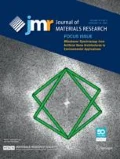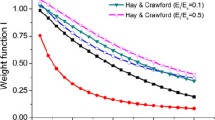Abstract
Part I [D.J. Morris and R.F. Cook, J. Mater. Res.23, 2429 (2008)] of this two-part work explored the instrumented indentation and fracture phenomena of compliant, low-dielectric constant (low-κ) films on silicon substrates. The effect of film thickness and probe acuity on the fracture response, as well as the apparent connection of this response to the perceived elastic modulus, were demonstrated. These results motivate the creation of a fracture model that incorporates all of these variables here in Part II. Indentation wedging is identified as the mechanism that drives radial fracture, and a correction is introduced that adjusts the wedging strength of the probe for the attenuating influence of the relatively stiff substrate. An estimate of the film fracture toughness can be made if there is an independent measurement of the film stress; if not, a critical film thickness for channel-cracking under the influence of film stress may be estimated.

















Similar content being viewed by others
References
D.J. Morris R.F. Cook: Indentation fracture of low-dielectric constant films: Part I. Experiments and observations. J. Mater. Res. 23(9), 2429 2008
D.J. Morris R.F. Cook: Radial fracture during indentation by acute probes: I. Description by an indentation wedging model. Int. J. Fract. 136, 237 2005
B.R. Lawn: Fracture of Brittle Solids Cambridge University Press Cambridge, UK 1993
G.R. Anstis, P. Chantikul, B.R. Lawn D.B. Marshall: A critical evaluation of indentation techniques for measuring fracture toughness. I. Direct crack measurements. J. Am. Ceram. Soc. 64, 533 1981
D.M. Marsh: Plastic flow and fracture of glass. Proc. R. Soc. London A 282 1965
A. Arora, D.B. Marshall, B.R. Lawn M.V. Swain: Indentation deformation/fracture of normal and anomalous glasses. J. Non-Cryst. Solids 31, 415 1979
R.F. Cook G.M. Pharr: Direct observation and analysis of indentation cracking in glasses and ceramics. J. Am. Ceram. Soc. 73, 787 1990
D.J. Morris, S.B. Myers R.F. Cook: Sharp probes of varying acuity: Instrumented indentation and fracture behavior. J. Mater. Res. 19, 165 2004
D.J. Morris, A.M. Vodnick R.F. Cook: Radial fracture during indentation by acute probes: II, Experimental observations of cube-corner and vickers indentation. Int. J. Fract. 136, 265 2005
G.M. Pharr, D.S. Harding W.C. Oliver: Measurement of fracture toughness in thin films and small volumes using nanoindentation methods in Mechanical Properties and Deformation Behavior of Materials Having Ultra-Fine Microstructures, edited by M. Nastasi, D.M. Parkin, and H. Gleiter (NATO ASI, Boston, MA, 1993) p. 449
D.J. Morris R.F. Cook: In situ cube-corner indentation of soda-lime glass and fused silica. J. Am. Ceram. Soc. 87, 1494 2004
H. Tada, P.C. Paris G.R. Irwin: The Stress Analysis of Cracks Handbook ASME Press New York 2000
H. Gao, C-H. Chiu J. Lee: Elastic contact versus indentation modeling of multi-layered materials. Int. J. Solids Struct. 29, 2471 1992
H. Xu G.M. Pharr: An improved relation for the effective elastic compliance of a film/substrate system during indentation by a flat cylindrical punch. Scr. Mater. 55, 315 2006
J. Mencik, D. Munz, E. Quandt, E.R. Weppelmann M.V. Swain: Determination of elastic modulus of thin layers using nanoindentation. J. Mater. Res. 12, 2475 1997
H. Song, G.M. Pharr A. Rar: Assessment of new relation for the elastic compliance of a film-substrate system in Thin Films: Stresses and Mechanical Properties I, edited by C.S. Ozkan, L.B. Freund, R.C. Cammarata, and H. Gao (Mater. Res. Soc. Symp. Proc. 695, Warrendale, PA, 2002), p. 431
J.L. Beuth: Cracking of thin bonded films in residual tension. Int. J. Solids Struct. 29, 1657 1992
A.R. Zak M.L. Williams: Crack point singularities at a bi-material interface. J. Appl. Mech. 30, 142 1963
J.W. Hutchinson Z. Suo: Mixed mode cracking in layered materials. Adv. Appl. Mech. 29, 63 1992
J. Dundurs: Discussion of edge-bonded dissimilar orthogonal elastic wedges under normal and shear loading. J. Appl. Mech. 36, 650 1969
J.J. Vlassak: Channel cracking in thin films on substrates of finite thickness. Int. J. Fract. 120, 299 2003
T. Suga, G. Elssner S. Schmauder: Composite parameters and mechanical compatibility of material joints. J. Compos. Mater. 22, 917 1988
B.N. Lucas, J.C. Hay W.C. Oliver: Using multidimensional contact experiments to determine Poisson’s ratio. J. Mater. Res. 19, 58 2004
B.N. Lucas, J.C. Hay W.C. Oliver: Using multi-dimensional contact mechanics experiments to measure Poisson’s ratio of porous low-k films in Materials, Technology and Reliability for Advanced Interconnects and Low-k Dielectrics—2003, edited by A.J. McKerrow, J. Leu, O. Kraft, and T. Kikkawa (Mater. Res. Soc. Symp. Proc. 766, Warrendale, PA, 2003), p. 177
K.E. Evans A. Alderson: Auxetic materials: Functional materials and structures from lateral thinking! Adv. Mater. 12, 617 2000
W. Yang, Z-M. Li, W. Shi, B-H. Xie M-B. Yang: Review on auxetic materials. J. Mater. Sci. 39, 3269 2004
A. Alderson K.E. Evans: Molecular origin of auxetic behavior in tetrahedral framework silicates. Phys. Rev. Lett. 89, 2255031 2002
T.C.T. Ting T. Chen: Poisson’s ratio for anisotropic elastic materials can have no bounds. Q. J. Mech. Appl. Math. 58, 73 2005
R.S. Lakes: Negative Poisson’s ratio materials. Science 238, 551 1987
G. Simmons H. Wang: Single Crystal Elastic Constants and Calculated Aggregate Properties: A Handbook MIT Press Cambridge, MA 1971
T.Y. Tsui, A.J. McKerrow J.J. Vlassak: Constraint effects on thin film channel cracking behavior. J. Mater. Res. 20, 2266 2005
T. Nakamura S.M. Kamath: Three-dimensional effects in thin film fracture mechanics. Mech. Mater. 13, 67 1992
J.M. Jacques, T.Y. Tsui, A.J. McKerrow R. Kraft: Environmental effects on crack characteristics for OSG materials in Thin Films—Stresses and Mechanical Properties XI, edited by T.E. Buchheit, A.M. Minor, R. Spolenak, and K. Takashima (Mater. Res. Soc. Symp. Proc. 875, Warrendale, PA, 2005). O10.6
S.M. Wiederhorn: Fracture surface energy of glass. J. Am. Ceram. Soc. 52, 99 1969
J.J. Petrovic: Review: Mechanical properties of ice and snow. J. Mater. Sci. 38, 1 2003
G.D. Quinn R.C. Bradt: On the Vickers indentation fracture toughness test. J. Am. Ceram. Soc. 90, 673 2007
A.A. Volinsky, J.B. Vella W.W. Gerberich: Fracture toughness, adhesion and mechanical properties of low-k dielectric thin films measured by nanoindentation. Thin Solid Films 429, 201 2003
J.B. Vella, I.S. Adhihetty, K. Junker A.A. Volinsky: Mechanical properties and fracture toughness of organo-silicate glass (OSG) low-k dielectric thin films for microelectronic applications. Int. J. Fract. 120, 487 2003
Author information
Authors and Affiliations
Corresponding author
Rights and permissions
About this article
Cite this article
Morris, D.J., Cook, R.F. Indentation fracture of low-dielectric constant films: Part II. Indentation fracture mechanics model. Journal of Materials Research 23, 2443–2457 (2008). https://doi.org/10.1557/jmr.2008.0295
Received:
Accepted:
Published:
Issue Date:
DOI: https://doi.org/10.1557/jmr.2008.0295




